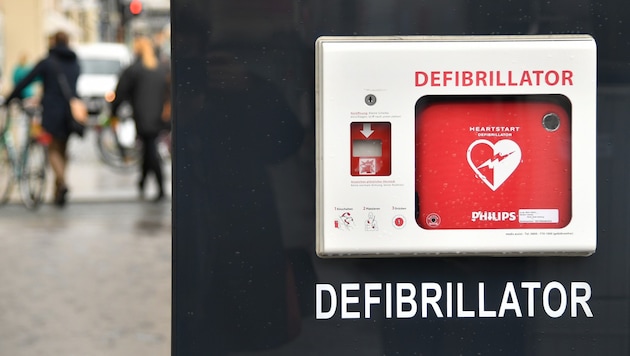Map for Upper Austria
Red Cross reminds of “Google Maps” for defibrillators
The rapid use of defibrillators saves lives. The so-called AEDs can also be easily operated by laypersons. To make them easier to find, the Red Cross shows their locations on a map. However, there is often a lack of knowledge about them and more information from the local authorities is needed.
"First aid is simple," explains Jakob Fischer from the Upper Austrian Red Cross. This applies in particular to help provided by automated external defibrillators (AEDs). These can be operated by laypeople without training: The devices give instructions themselves, measure the affected person's heart action, decide whether an electric shock is necessary and set the pace for cardiac massage and ventilation. This is intended to take away the fear of helpers doing something wrong. "You need to know what needs to be done and have the courage to do it," says Health Officer Christine Haberlander (ÖVP), emphasizing the need to act quickly in an emergency.
Locations visible on a map
In Upper Austria, 2400 AEDs are maintained by the Red Cross and serviced at least once a year. In total, there are around 2700 that are publicly accessible. Since 2018, their locations have been shown on the defibrillator map, which is available at definetzwerk.at. Even when an emergency call is made, the dispatchers in the relevant control center can see the map. "We stay on the phone until the ambulance arrives and tell callers where the nearest defibrillators are," explains Franz Hauzenberger from the Red Cross Linz control center.
Every third victim saved
Nevertheless, there is often a lack of knowledge about AEDs. "It would be desirable if the municipalities were to publicly announce the locations at least once a year," says Walter Aichinger, President of the Upper Austrian Red Cross. As most first aid measures are necessary in the home, it is important to know where defibrillators are located. Finding them quickly increases the chances of survival, because every minute counts in the event of cardiac arrhythmia. At the moment, on average one in three people affected can be saved with the help of a defibrillator. More knowledge about AEDs and their use should increase this figure. "We want to increase the resuscitation rate," says Aichinger.
This article has been automatically translated,
read the original article here.











Willkommen in unserer Community! Eingehende Beiträge werden geprüft und anschließend veröffentlicht. Bitte achten Sie auf Einhaltung unserer Netiquette und AGB. Für ausführliche Diskussionen steht Ihnen ebenso das krone.at-Forum zur Verfügung. Hier können Sie das Community-Team via unserer Melde- und Abhilfestelle kontaktieren.
User-Beiträge geben nicht notwendigerweise die Meinung des Betreibers/der Redaktion bzw. von Krone Multimedia (KMM) wieder. In diesem Sinne distanziert sich die Redaktion/der Betreiber von den Inhalten in diesem Diskussionsforum. KMM behält sich insbesondere vor, gegen geltendes Recht verstoßende, den guten Sitten oder der Netiquette widersprechende bzw. dem Ansehen von KMM zuwiderlaufende Beiträge zu löschen, diesbezüglichen Schadenersatz gegenüber dem betreffenden User geltend zu machen, die Nutzer-Daten zu Zwecken der Rechtsverfolgung zu verwenden und strafrechtlich relevante Beiträge zur Anzeige zu bringen (siehe auch AGB). Hier können Sie das Community-Team via unserer Melde- und Abhilfestelle kontaktieren.